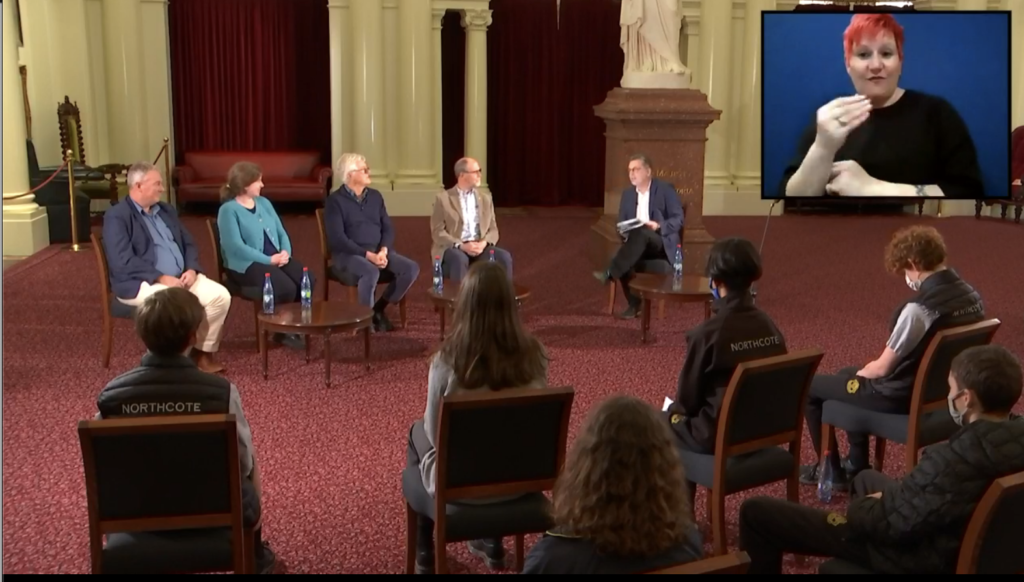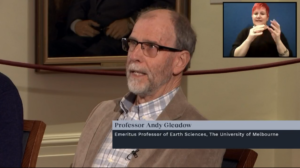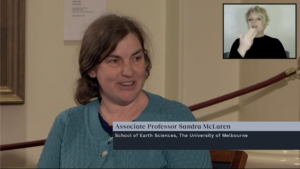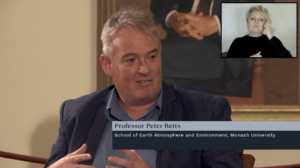A Hard-Won Theory: Tectonic Plates in Victoria
by Catriona Nguyen-Robertson
RSV Science Communications Officer

The STEM and Society series of online presentations explores the science and stories behind the game-changing work undertaken by Victoria’s scientific community. Leading experts spoke about the work they are doing to engage the community and bring about meaningful change in their field of study and in our everyday lives. This series was presented by the Victorian Parliament, in partnership with the Royal Society of Victoria, the Victorian Parliamentarians for STEM and supported by Inspiring Victoria.
This article follows a panel discussion on 14th July 2021 with four eminent Victorian Geologists: Professor Peter Betts, Dr William Birch AM, Professor Andy Gleadow and Associate Professor Sandra McLaren.

How do we distinguish scientific truths? Among a midst of misinformation and personal opinions that are presented as facts with unwavering certainty, it can be a challenge. It can be especially confusing when we hear from scientists, who rarely speak in absolutes but rather discuss ‘degrees of certainty.’ In the world of science, a ‘theory’ is the closest we may ever come to ‘the truth’.
To understand the process of how modern scientists arrive at an accepted theory, the RSV convened a panel with the Parliament of Victoria to take us through one of the major revelations of the past century: tectonic plate theory.
‘Plate tectonics’ describes fragments of the Earth’s outer shell that move against, over, and under one another at their boundaries. The dynamic movement of these fragments and interaction at their boundaries slowly changes the shape and location of our continents and oceans. The theory revolutionised the Earth sciences field by providing a context to understand how mountains are built, volcanoes erupt, and earthquakes are triggered.
While the theory is now a given, it wasn’t always.
 The idea of continental drift was first proposed in 1915 but was universally denied. Geophysicist and meteorologist, Alfred Wegener, hypothesised that the continents were once joined together, broke up, and drifted away. Fossils of the same species across land masses, continuing glaciers and complementary coastlines hold clues to their distant past. Antarctica’s mountains are an extension of the Andes Mountains. Africa and South America (and other continents) fit perfectly together like pieces of a jigsaw puzzle. Some fossil remains of an individual species have been found strewed across all continents in the Southern Hemisphere, indicating that they were once connected.
The idea of continental drift was first proposed in 1915 but was universally denied. Geophysicist and meteorologist, Alfred Wegener, hypothesised that the continents were once joined together, broke up, and drifted away. Fossils of the same species across land masses, continuing glaciers and complementary coastlines hold clues to their distant past. Antarctica’s mountains are an extension of the Andes Mountains. Africa and South America (and other continents) fit perfectly together like pieces of a jigsaw puzzle. Some fossil remains of an individual species have been found strewed across all continents in the Southern Hemisphere, indicating that they were once connected.

But Wegener had no good model to explain how the continents moved apart. Highlighting the importance of scientific evidence, while most of Wegener’s observations about fossils and rocks were indeed correct – they do fit together – he was wrong on several key points and had no mechanism to back his theory.
In thinking about how land masses fit together, everyone neglected the oceans. Over two thirds of the planet is covered water, but there was very little understanding of it. It wasn’t until we had data on the ocean floors that the theory started coming together.

In the 1950’s, magnetic instruments (magnetometers) began detecting odd magnetic variations across the ocean floor. There appeared to be stripes of rock with alternating polarities: either aligned with the Earth’s present magnetic field or the reversed polarity. Fred Vine, a PhD student under Drummond Matthews, published a Nature paper in 1963 to explain the intriguing magnetic striping. When magma from the Earth’s mantle rises through mid-ocean ridges and cools, it adds new rock to the ocean floor in layers. But because the Earth’s magnetic field switches direction over time, the new lines of oceanic crust being deposited reflects Earth’s magnetic orientation at the time.
Canadian geologist Lawrence Morley independently arrived at the same idea but faced resistance. He struggled to publish a paper as reviewers were hostile to such a revolutionary idea. Once the Vine-Matthews-Morley hypothesis was finally more generally accepted, it became crucial in the theory of plate tectonics. Within three years, the entire ocean floor had been dated using magnetic striping.

Then Marie Tharp, a geologist and oceanographer, created maps that changed the way people view the oceans. Most scientists assumed that the seabed was featureless, but her maps detailed mountains, valleys and trenches along the ocean floor. While Wegener couldn’t explain how Africa and South America had drifted apart, Tharp identified mountains and a rift valley in the centre of the Atlantic Ocean where the two continents had been ripped apart.
Tharp’s work was dismissed by her research partner as “girl talk.” But when another researcher plotted locations of earthquake epicentres and they fell within Tharp’s rift valley, everything changed. The pieces of the puzzle were coming together.

‘It wasn’t until we understood the oceans that we could make that step forward,’ says Professor Peter Betts.
As evidence accumulated, opposition to the theory diminished. There was a paradigm shift in thinking, but it did take a while to trickle down into schools. When Peter Betts, William Birch, Andy Gleadow, and Sandra McLaren were young geologists or school students, plate tectonics were still not a given. It certainly was not taught in schools and some lecturers at university were resistant to teaching it or were uninformed of the new ideas.
Scientists were more siloed within individual fields, but the people driving the evolution of plate tectonic theory thought across boundaries. Interdisciplinary teams of scientists now come together to solve problems. While Vine and Matthew’s 1963 paper had the only the pair authors, most modern research papers have at least ten researchers working toward the same goal bringing in slightly different angles. This is how we can probe, interrogate, and arrive at “scientific truths.”
One of the most important outcomes of plate tectonic theory is that we can better predict when earthquakes and tsunamis occur or when volcanoes will erupt. It is important to acknowledge that scientists can be mistaken in their hypotheses (like Wegener was), but when several scientists work together or independently produce data that supports each other, we can be more confident in scientific information as it evolves.
Video (Facebook Live):






